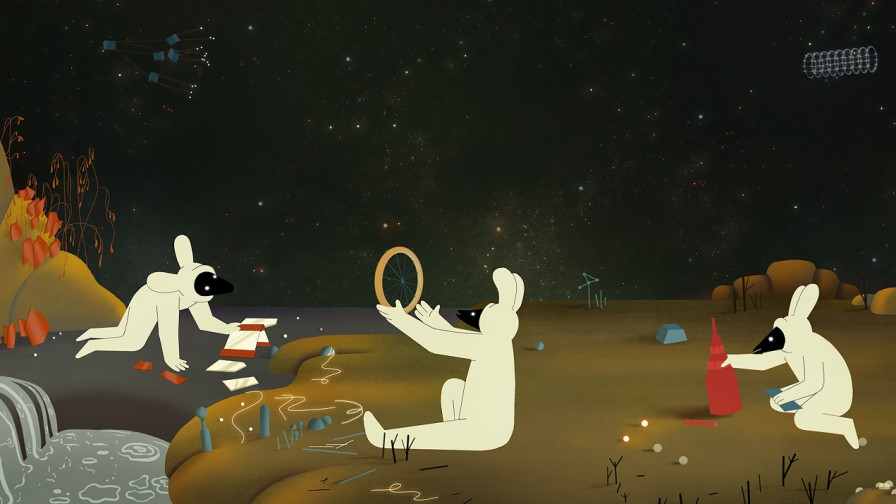"To Depict The Unimaginable"
The third film by Réka Bucsi will debut at Berlinale. Her graduation film Symphony no. 42 came out back in 2014, which was followed by LOVE in 2016. This year, her latest work, Solar Walk, is a 20-minute short film that follows the genre of science fiction, while using different techniques. All three films have one thing in common, besides all of them debuting at Berlinale Shorts: they try to find the human race’s place in the universe. Solar Walk was originally created as a 50-minute background animation for a concert by the Danish Aarhus Jazz Orchestra. Basing herself on that, Réka created a new 20-minute version.
How did the Solar Walk project begin?
The Aarhus Jazz Orchestra wanted a background animation for one of their concerts, then supported by the Animation Workshop, and so they were looking for a director. We began to talk about it two years ago, and back then I didn’t really believe that it would actually happen, as it seemed to be such a big project. At first I was afraid of it, thinking it would be too hard to do it in such a short time – I only had four and a half months to work on it. But it turned out to be a great learning experience.
Does this animation have an actual story? Did the Orchestra already have the sci-fi theme or did you come up with that by yourself?
The idea was to do something like Disney’s Fantasia (1940). I was working with the MIDI version of the music, which had no orchestration. I created the storyboard using that and the songs. The theme that I was told to follow was space travel, which runs through the entire six chapters that make up the concert. The instructions that I was given were to show the role of people in space travel, and to do so in a philosophical way by presenting their place in this vast universe: where they stand in it all and how they feel about it. Since I had very little time to write the storyboard and to prepare the production, I wrote associatively and came up with a playful story, which follows one character after the other.
Science fiction is a theme that is present in both LOVE and Symphony no. 42. What draws you to sci-fi?
That it offers me endless possibilities. I can come up with anything and do it in whatever way I can think of. But it is another interesting challenge to depict what’s practically unimaginable: to somehow depict space and time. A space that we could not comprehend at first. Yet this provides all kinds of abstract situations and ways of depiction. I love philosophical sci-fi films, such as 2001: Space Odyssey and Stalker. That’s the path I follow in my films. In ‘Solar Walk’, for example, I tried to counteract the serious lyrics with ironic and sarcastic humour.
The definitive part of your film is the sound design created by Péter Lukács. Wasn’t it strange not to have that in the 50-minute background animation?
Yes, it was strange, especially during the creation of the storyboard, as there were several times when I had to drop an idea because it would only have worked with foley and not with music. This made me realise just how much I actually think in foley sounds. The 20-minute short film version does have foley effects that were made by Péter Lukács as well as new music composed by Mads Vadsholt.

Solar Walk by Réka Bucsi
How should we imagine the recreation of a complete 50-minute film into a short film?
I have never done such a thing before – to cut a finished animation film. Had it not worked, I would not have made the effort to edit it. However, we could not create a whole film in only four and a half months. So we made freeze frame shots and loops, which helped us create a tightly edited version. The other big challenge in this whole project was that I had to think up things that not only look good, but that also keep the viewer interested, even though nothing really happens. It was the only way to finish the film on time. For example, there are a number of scenes that are all one-minute takes without a single cut. For these I had to come up with situations that would unfold slowly, while also look good. For the project I combined techniques to the highest degree, for example I mixed 3D with 2D. There are several scenes that were very technically complex and required other people throughout different stages of the production. We had to do a lot of simulated animations that we could loop. But to keep them interesting, we added some other technical elements as well.
So the next step would be an even bigger project?
I would love to do a feature film, but we’ll see what comes of that. If the script doesn’t need it, then my next film may not be an animation. I would like to focus on writing for now and not just on depicting something in a visual way. Still, there may be a combination of the two, but if something doesn’t want to work, then I won’t force it. For now, writing a dialogue or a narration is a new challenge. I write it first and then try to figure out how it should look. ‘Solar Walk’ is still quite fresh for me, so I don’t have any big plans at the moment, just small ideas, small visual experiments, that came out of the technical studies of the film. I’m also interested in animation beyond cinema: I’m curious about animation as an art form and how to bring it into an exhibition space.
Zsófi Herczeg
